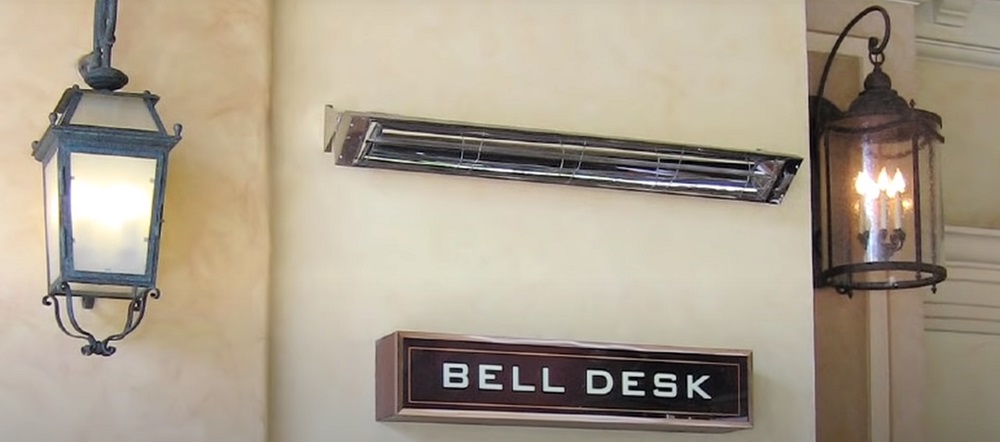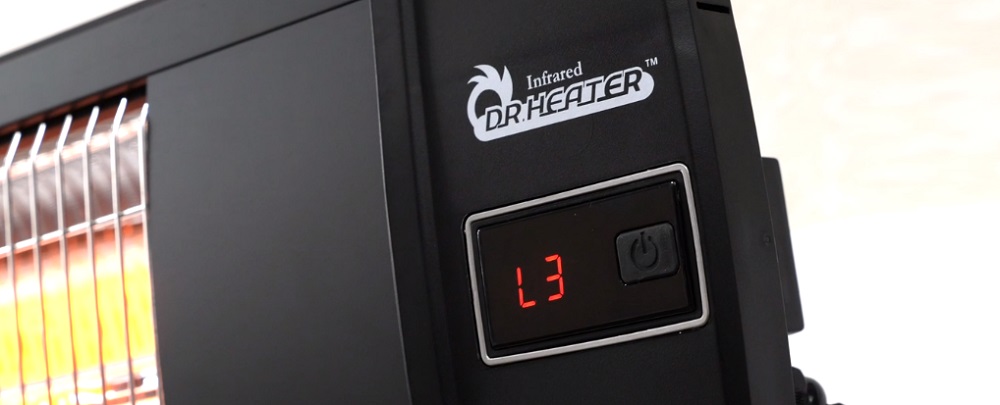There’s nothing cozier than sitting on your patio with friends and family, enjoying a cold beer, and watching the sun slowly go down… Until the sun has fully set and you’re left with just the frigid nighttime air for company. If you’re looking to keep your patio adequately heated with a permanent wall fixture, then a wall-mounted patio heater is your best option. Below, you’ll find out top picks of the best wall-mounted patio heater to make your autumn nights more enjoyable.

Wall-Mounted Patio Heater Buying Guide
In the following section, you’ll learn about all about wall-mounted patio heaters—what they are, why you might need one, the benefits of this type of heater, and how to find the perfect wall-mounted heater for your patio. You can refer to this guide while comparing the models listed above.
What Is a Wall-Mounted Patio Heater?
The name pretty much tells the whole picture. A wall-mounted patio heater is an outdoor heater made to be fastened onto a wall instead of being mounted onto a concrete slab on the ground or freestanding on a flat surface.
Wall-mounted patio heaters come in a variety of types, styles, and capacities. Before you choose a wall-mounted patio heater, make sure you know what sort of options are available.
Types of Wall-Mounted Patio Heaters
There are several ways to define the various types of wall-mounted patio heaters. Here, we’ll focus specifically on how they keep your patio nice and toasty. The most common types are convection heaters and radiant heaters.
Convection Heaters
Convection heaters are the more traditional type of heaters. If you have a convection oven at home, then you probably already understand what a convection outdoor heater is about. To put it simply, convection heaters heat up the surrounding air which then transfers some of the heat to nearby objects.

These devices typically require longer times to raise the temperature of a room, depending on the heating element’s capacity and room size. As warm air rises, it displaces cold air molecules, which then come into contact with “newly-made” warm-air molecules. Eventually, the air in an entire room becomes heated to an equal degree.
Radiant Heaters
Radiant heaters work a lot differently from convection heaters. First, they emit infrared radiation that travels through the air without losing energy. Only after the infrared beams collide into an object (a table, a char, the unfortunate beer in your hand, and yourself) does heat begin to transfer.
Radiant heaters do not rely on the movement of air to transfer heat, unlike convection heaters that will heat up one particular area without air circulation. In the end, radiant heaters take less time to raise the temperature of surrounding objects to a comfortable degree, and only a negligible amount gets lost when a door opens (drafts can cool down objects).
Why Choose a Wall-Mounted Patio Heater?
A quick Google search will show you that there is more than one type of patio heater available. You have freestanding, tabletop, fireplace, and wall-mounted patio heaters. We’ll briefly describe the benefits of a wall-mounted patio heater down below.

Out of the Way
First of all, wall-mounted patio heaters are up and out of the way. There’s very little risk that one of your guests will accidentally bump their head or shoulder against a wall-mounted heater, though you need to be mindful of how high you place it.
Pro Tip. Do not place a wall-mounted patio heater too far up a wall. Warm air is less dense than cold and will float upward. If the heater is too far up, only your ceiling or the open sky will enjoy the heat.
Inexpensive Operating Cost
Wall-mounted patio heaters use either electricity or natural gas. They don’t cost nearly as much as liquid propane, which is sold by the tankful (usually 20 pounds).
Did You Know. Although propane is costlier by the unit, a little can go a long way. On average, it takes propane half as much in volume to produce heat compared to natural gas. However, propane tanks are impractical for wall-mounted patio heaters since you need to create a space to accommodate the bulky tank.
Permanent Fixture
Wall-mounted patio heaters are mounted onto brackets or some other fastening system. The heaters sit there permanently until you dismantle and relocate the bracket. These are great for patios since your patio isn’t going anywhere. However, if you want to take your party to the yard, then you might experience some issues.

Crucial Wall-Mounted Heater Specs
Here, we’ll quickly go over the most important wall-mounted patio heater specs and how they relate to your patio.
Heating Capacity
The heating capacity of a patio heater is measured in British Thermal Units or BTUs. The higher the BTU rating, the wider an area it can heat or the quicker it will work in smaller spaces. However, there is such a thing as going overboard when calculating the heating capacity. Take a good, hard look at the products specs and see whether they fit your patio.
Helpful Tool. This helpful online BTU calculator (link: https://www.calculator.net/btu-calculator.html) can help determine the appropriate BTU rating for your patio. This will come in handy if the manufacturer does not provide a best-for-room-size figure.
Natural Gas vs. Electricity
Between natural gas and electricity, natural gas is by far the cheaper fuel source alternative. However, this depends on where you live and how readily available each type of fuel source is. Additionally, electric heaters are simple plug-and-play devices, whereas natural gas heaters require rerouting a gas line to your patio.
Caution. Please hire a professional technician to reroute the gas line. Attempting to do so yourself may lead to hidden leaks. Installation can be pretty pricey, but it’s worth it if the alternative is blowing your home up.
Convection vs. Radiant
Earlier, we described what these types of heaters are. Now, let’s see which is more appropriate for your patio.
Convection heaters rely on circulating air to transport heat from the device to surrounding objects. They’re less efficient but can work great in covered patios. Radiant heaters are more efficient and do not lose energy from moderate gusts of wind. If you have an uncovered patio, choose a radiant heater.
Wall-Mounted Patio Heater Features
Here are some nice-to-have and must-have features to look for in a wall-mounted patio heater.

Remote Control
While you’re firmly planted on your patio furniture, there’s nothing worse than having to get up and adjust the heater’s temperature setting. A remote control lets you change temp settings from a reasonable distance, though your greatest worry becomes losing the remote.
IP65 Protection against Water and Dust
Since wall-mounted patio heaters are permanent fixtures, it’d be a good idea to find a heater that is rated IP65 for protection against dust and moderate splashes of water. If it floods, there’s nothing you can do except unfasten the patio heater and cheese it.
Heat Settings
Some models come with multiple heat settings to work optimally in different room sizes or accommodate more people.
Did You Know. We know, we said that wall-mounted patio heaters are permanent wall fixtures. What we meant is that they need to be mounted onto a bracket that is permanently set in place. You can remove the heater and relocate it to another room, provided that its new destination also has a mounting bracket (additional brackets are sold separately).
Adjustable Bracket Angle
Changing the angle of the bracket will allow you to direct more heat or infrared radiation to a particular part of your patio. Most brackets tilt up and down, so be mindful of how you set the bracket up.
Direct Spark Ignition
If you’ve every turned a car on, then you know what direct spart ignition is. Instead of dropping a match or using a lighter to ignite the gas, the device will produce a spark on its own with a simple turn of the ignition dial. This is for natural gas models only.
FYI. A patio canopy or tarp is a quick, semi-permanent, cost-efficient way of providing open-air patios with much-needed covering. These systems might help block a majority of the wind passing through.
FAQs
Yes, especially in town that experience high winds. Even though infrared radiation does not lose much energy through the air, gusts of wind can cool down the objects surrounding the heater, rendering the device completely useless. If there’s no wind, there’s no problem (for radiant heaters, anyway).
You bet they do! Patio heaters aren’t much different from indoor heaters, except that they can move around (freestanding) or are permanently placed outdoors (wall-mounted and radiant fireplace heaters). They produce quite a bit of heat that should keep you and your guests nice and cozy during autumn and winter.
They are both equally good in terms of heating performance. However, electricity is more expensive in a majority of towns and cities as opposed to natural gas. However, you’ll need to take the hefty cost of installing a new gas line to your patio if you choose a gas wall-mounted patio heater. Also, they can be just as wasteful if you leave them running for long periods of time.
On average, you can expect to get at least a decade’s worth of outdoor heating from a wall-mounted patio heater. As long as you check up on it regularly for fixable parts, keep it indoors and out of rain when not in use, and the hose isn’t leaking (gas models) or the cord isn’t frayed (electric models), your patio heater can easily reach the decade-long mark.
If you have any questions or comments, please add them below in the comment section. Similarly, please let us know if you spot any mistakes or omissions. Thanks!
Last Update: 2024-04-24 | Affiliate links/Images from Amazon Product Advertising API



